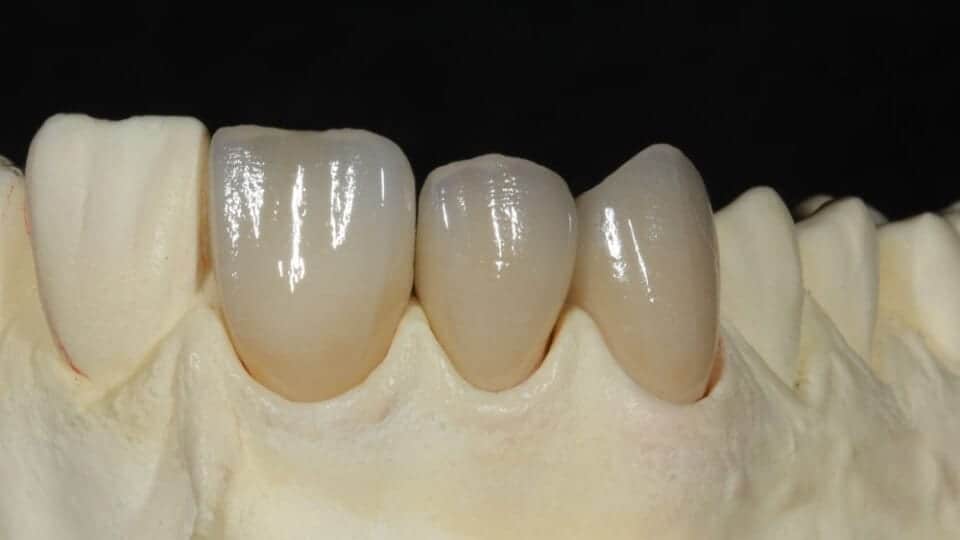Erica has come in to the Keating operatory inside our Irvine Dental Lab for new veneers. First need to take off the older, more opaque veneers. The replacemnt veneers will be with Keating Dental Lab, e.max lithium disilicate veneers done here in our dental lab. We’re using the LiteTouch dental laser for the procedure, which allows us to do this procedure with very little pain and much more efficiently than grinding them off with diamond burrs.
Product Spotlight: IPS e.max, Lithium Disilicate Restorations:
Removing Veneers with Hard Tissue Dental Laser
One of the main reasons we’re using the LiteTouch, and Erbium YAG dental laser, is that we want to minimize the trauma to her teeth.The new, harder porcelains like the lithium disilicate can be difficult to cut through, and getting the cement off often means taking off some enamel, as well.
We’ve found that by using an Erbium YAG laser, we’re able to go through the ceramic and remove the cement. This hybrid zone expands, and the porcelain breaks off. Often, we’re able to get veneers off in one piece by using this method, which means that we could potentially take the veneer off, send it to the lab to get refinished, then place it back on.
Now, we won’t be recementing these, but it will still save us time and wear and tear on the handpiece. Because of how these veneers were placed in Erica’s mouth, we may not be able to get them out in one piece, but we’ll still hear a sort of snap and the porcelain will break off in a few pieces and we can peel the rest off, then polish off the remaining cement.
Restoration Removal with the LiteTouch Laser
Since this is an Erbium YAG laser, which is a pulse laser, we’ll hear some tapping, but there’s very little to no discomfort for the patient. We’ll then take the handpiece, which is at a 60 degree angle instead of a 90 degree, which makes it easier to handle. This doesn’t require much energy, so we’ll start with it low and move it across the surface of the restoration.
Dr. Hornbrook typically sets a timer to ensure he knows just the amount of time he’s spending on each veneer, and the LiteTouch dental lasers have one included. It will typically take 60-90 seconds to remove each veneer, but we’re moving in 30 second increments.
We’ll start with the left central, and again, the laser energy is moving through the glass and penetrating the cement. Due to the thickness of these restorations, and the face that they’re similar to reverse three-quarter crowns, the previous dentist went interproximally.
This means they won’t pop out in one piece, but that’s okay. It’s difficult to get the laser energy in that interproximal area, so we’ll have to make a slot down the veneer. We’ll then take a crown separator and place it in the slot, and the pieces come right off. The laser aided in removing most of it, at least the bond, then we used the slot to finish the job.
We’ll then move to the laterals with the same technique. The lateral is similar to the centrals, in that the veneer is also wrapped interproximally, so we’ll try to get the laser in there, but it may not remove all of it. So we’ll make another groove like we did with the central, but we’re not going to go into the prep.
How the LiteTouch Works with Veneers
You’ll see the the laser disrupts the cement and it starts browning; that’s the cement becoming discolored as it’s removed, and the ceramic is still intact and can be polished off. On the distal, then, Dr. Hornbrook takes a number 12 Bard-Parker blade and easily pops the veneer off. After these veneers are removed, we’re going to go in and polish it up, and you’ll see that the enamel is intact.
You can see the bubbles coming over the margin in the video from our dental lab overhead camera; the canine is also opaque and wrapped over interproximally, as well, onto the lingual. Because these are older Emax, it’s difficult to even make the slot.
You can imagine how difficult and labor intensive it would be to grind all these off, which is why using the LiteTouch is so great for this procedure. This difficulty in removing existing veneers is often the most difficult part of the process.
Now, we’re going to do a little experiment to show how the Erbium YAG laser makes a difference. We’re going to use the laser after making the slot, and we can see the cement turning brown from the laser. After only 30 seconds we’re able to pop the veneer off, instead of spending time grinding incredibly strong materials off the tooth.
Other than the LiteTouch being an incredibly diverse tool for your practice, it saves you time, diamond burrs, and helps minimize trauma for your patient’s teeth. Using an Erbium YAG for veneer removal has saved us time, and we hope this has been a helpful example of restoration removal using a LiteTouch laser.













